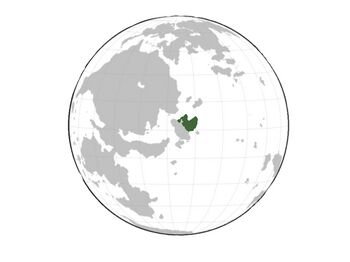User:Rhava
Empire of Two Abodes (Mulak Empire) Thaichhati (Rha)
| |
|---|---|
| 331 AD–$$$ | |
|
Flag | |
 Mulak Empire at greatest extent | |
| Capital | Cúbūmā ($$$) |
| Official languages | Standard Rha |
| Common languages | Rawang, Nhai, Kham Rha family, Sokhaos, Linh, Sichaeng and scores of smaller languages. |
| Religion | Bikåmmā |
| Government | absolute monarchy |
| Mâhåt Rhā | |
• 331-$$$ | Pheihavànphê Sâthōu |
• $$$ | Thú Khōnkhumthat |
• $$$ | TBD |
• $$$-558 | Khedôki Vaisālib |
| Historical era | Pre-Colonial era |
• Pheihavànphê Sâthōu created the Thaichhati | 331 AD |
• TBD | $$$ |
• TBD | $$$ |
• TBD | $$$ |
| Area | |
| $$$$$$ | [convert: invalid number] |
The Inca Empire, also known as the Incan Empire and the Inka Empire, and at the time known as the Realm of the Four Parts,[a] was the largest empire in pre-Columbian America.[2] The administrative, political and military center of the empire was in the city of Cusco. The Inca civilization arose from the Peruvian highlands sometime in the early 13th century. The Spanish began the conquest of the Inca Empire in 1532 and its last stronghold was conquered in 1572.
From 1438 to 1533, the Incas incorporated a large portion of western South America, centered on the Andean Mountains, using conquest and peaceful assimilation, among other methods. At its largest, the empire joined Peru, western Ecuador, western and south central Bolivia, northwest Argentina, a large portion of what is today Chile, and the southwesternmost tip of Colombia into a state comparable to the historical empires of Eurasia. Its official language was Quechua.[3] The Inca Empire was unique in that it lacked many of the features associated with civilization in the Old World. Anthropologist Gordon McEwan wrote that the Incas were able to construct "one of the greatest imperial states in human history" without the use of the wheel, draft animals, knowledge of iron or steel, or even a system of writing.[4] Notable features of the Inca Empire included its monumental architecture, especially stonework, extensive road network reaching all corners of the empire, finely-woven textiles, use of knotted strings (quipu) for record keeping and communication, agricultural innovations and production in a difficult environment, and the organization and management fostered or imposed on its people and their labor.
The Inca Empire functioned largely without money and without markets. Instead, exchange of goods and services was based on reciprocity between individuals and among individuals, groups, and Inca rulers. "Taxes" consisted of a labour obligation of a person to the Empire. The Inca rulers (who theoretically owned all the means of production) reciprocated by granting access to land and goods and providing food and drink in celebratory feasts for their subjects.[5] Many local forms of worship persisted in the empire, most of them concerning local sacred Huacas, but the Inca leadership encouraged the sun worship of Inti – their sun god – and imposed its sovereignty above other cults such as that of Pachamama.[6] The Incas considered their king, the Sapa Inca, to be the "son of the sun".[7]
The Incan economy has been described in contradictory ways by scholars; Darrell E. La Lone, in his work The Inca as a Nonmarket Economy, noted that the Inca economy has been described as "feudal, slave, [and] socialist", and added "here one may choose between socialist paradise or socialist tyranny."[8]
- ↑ McEwan 2008, p. 221.
- ↑ Schwartz, Glenn M.; Nichols, John J. (2010). [[[:Template:Google books]] After Collapse: The Regeneration of Complex Societies] Check
|url=value (help). University of Arizona Press. ISBN 978-0-8165-2936-0. - ↑ "Quechua, the Language of the Incas". 11 November 2013.
- ↑ McEwan, Gordon F. (2006). The Incas: New Perspectives. New York: W.W. Norton & Co. p. 5.
- ↑ Morris, Craig and von Hagen, Adrianna (2011), The Incas, London: Thames & Hudson, pp. 48–58
- ↑ "The Inca – All Empires".
- ↑ "The Inca". The National Foreign Language Center at the University of Maryland. 29 May 2007. Retrieved 10 September 2013.
- ↑ La Lone, Darrell E. (1982). "The Inca as a Nonmarket Economy: Supply on Command versus Supply and Demand". Contexts for Prehistoric Exchange: 292. Retrieved 10 August 2017.
Cite error: <ref> tags exist for a group named "lower-alpha", but no corresponding <references group="lower-alpha"/> tag was found
